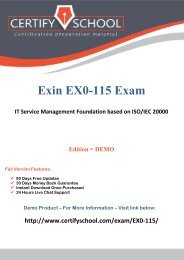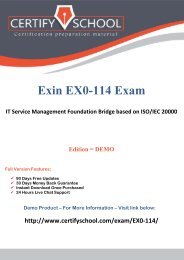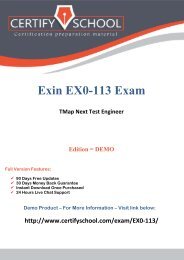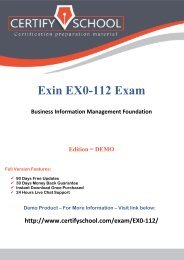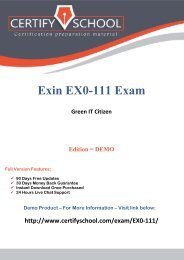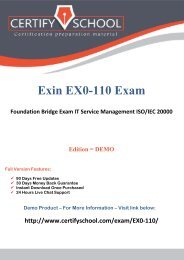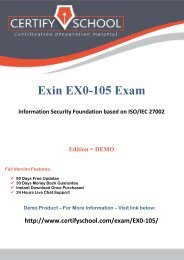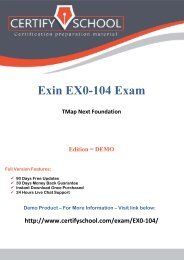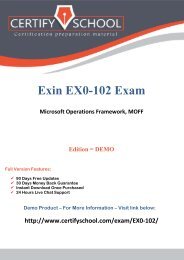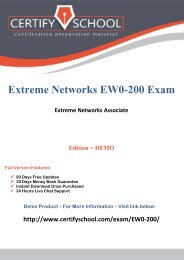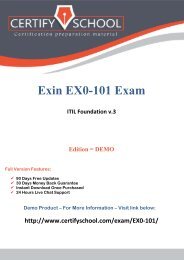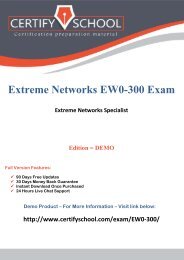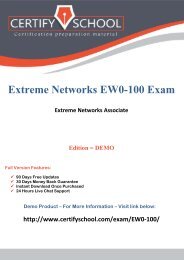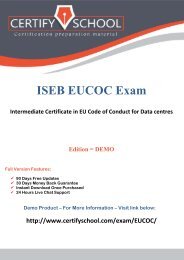CRISC Exam
For more Full product Details:www.CertifySchool.com Our workable study material for exam meets the exact and accurate exam questions and answers. So that’s why CertifySchool is popular in the field of IT Certification Exams material providers.Please visit site: www.certifyschool.com/
For more Full product Details:www.CertifySchool.com
Our workable study material for exam meets the exact and accurate exam questions and answers. So that’s why CertifySchool is popular in the field of IT Certification Exams material providers.Please visit site: www.certifyschool.com/
Create successful ePaper yourself
Turn your PDF publications into a flip-book with our unique Google optimized e-Paper software.
www.CertifySchool.com Certification Preparation Material (PDF)<br />
SLE = Asset value * Exposure factor<br />
Therefore,<br />
SLE = 200,000 * 0.45<br />
= $ 90,000<br />
As the loss is occurring once every month, therefore ARO is 12. Now ALE can be calculated as follows:<br />
ALE = SLE * ARO<br />
= 90,000 * 12<br />
= $ 108,000<br />
Question: 7<br />
Which of the following is NOT true for Key Risk Indicators<br />
A. The complete set of KRIs should also balance indicators for risk, root causes and business<br />
impact.<br />
B. They help avoid having to manage and report on an excessively large number of risk indicators<br />
C. They are monitored annually<br />
D. They are selected as the prime monitoring indicators for the enterprise<br />
Answer: C<br />
Explanation:<br />
They are monitored on regular basis as they indicate high probability and high impact risks. As risks change over<br />
time, hence KRIs should also be monitored regularly for its effectiveness on these changing risks.<br />
Answer: D, B, and A are incorrect. These all are true for KRIs. Key Risk Indicators are the prime monitoring indicators<br />
of the enterprise. KRIs are highly relevant and possess a high probability of predicting or indicating important risk.<br />
KRIs help in avoiding excessively large number of risk indicators to manage and report that a large enterprise may<br />
have.<br />
The complete set of KRIs should also balance indicators for risk, root causes and business impact, so as to indicate<br />
the risk and its impact completely.<br />
Question: 8<br />
You work as a project manager for SoftTech Inc. You are working with the project stakeholders to begin the<br />
qualitative risk analysis process.<br />
Which of the following inputs will be needed for the qualitative risk analysis process in your project<br />
Each correct answer represents a complete solution. Choose all that apply.<br />
A. Cost management plan<br />
B. Organizational process assets<br />
C. Project scope statement<br />
D. Risk register<br />
http://www.certifyschool.com/exam/<strong>CRISC</strong>/<br />
Answer: D, B, and C<br />
Explanation:<br />
The primary goal of qualitative risk analysis is to determine proportion of effect and theoretical response. The inputs<br />
to the Qualitative Risk Analysis process are:<br />
Organizational process assets<br />
Project Scope Statement<br />
Risk Management Plan<br />
Risk Register<br />
Page | 5




